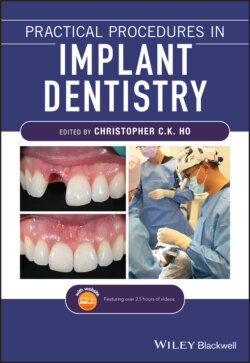Читать книгу Practical Procedures in Implant Dentistry - Группа авторов - Страница 31
3.1.1.2 Templates
ОглавлениеRadiographic templates can be used in diagnostic imaging, and these are based on desired tooth positions, and accordingly planned with correct spacing and biomechanical principles. These guides are used to determine if the desired implant prosthesis is possible and can assist the surgeon in determining if augmentation is required at the surgical site. They must replicate the desired final tooth position and must be stable during the process of taking the CBCT. There are various methods for creating radiographic guides including conventional analogue and more recent digital techniques:
The analogue technique traditionally starts from waxing up the desired teeth on articulated study models, creating a vacuum‐formed retainer or acrylic template, then filling the desired positions with a radiopaque material (Figure 3.1).
Digital techniques begin with intra‐oral scans and the desired tooth position is planned. The radiographic guide can then be milled or 3D printed.
Figure 3.1 Analogue/traditional radiographic template.
Templates (guides/stents) have various functions:
They simulate prescribed teeth in the intended implant sites. These are positioned according to prosthodontic planning with the numbers of implants as well as the position of the teeth for best aesthetics, function, and phonetics. The implants are positioned so that they are 1.5 mm away from teeth and 3 mm from adjacent implants.
They indicate any need to replace soft and/or hard tissues.
They are used in surgical site assessment, radiographic assessment, and surgical placement of implants. This may also allow visualisation to see whether screw retention is possible.
Radiographic templates constructed during the initial prosthetic work‐up may be used in conjunction with the CBCT, allowing the clinician to determine whether bone grafting will be needed and also to guide the clinician in choosing an appropriate prosthesis [3].
Various methods have been used to allow imaging with the use of gutta percha markers, radiopaque teeth, or barium sulfate in acrylic. The use of radiopaque gutta percha markers have been used to simulate the alignment of the implants which provide information about the intended placement on the cross‐sectional imaging. These gutta percha markers are then removed, and the radiographic templates can further be modified to become a surgical template (Figure 3.2). These templates indicate teeth position but are not precisely defined due to the fact that the surgeon may have to manually correct the placement of implants.
Figure 3.2 Acrylic radiographic/surgical guide.
The templates can be supported by teeth, implants, mucosa, and bone. They need to be stable, retentive, and to fit accurately as poor fit may lead to poor positioning of the template, leading to errors in the implant position. Furthermore, they should be rigid and not easily distorted when inserting.
